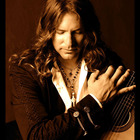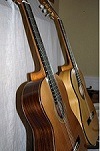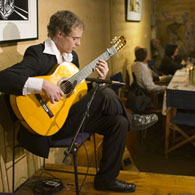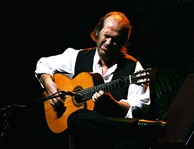Welcome to one of the most active flamenco sites on the Internet. Guests can read most posts but if you want to participate click here to register.
This site is dedicated to the memory of Paco de Lucía, Ron Mitchell, Guy Williams, Linda Elvira, Philip John Lee, Craig Eros, Ben Woods, David Serva and Tom Blackshear who went ahead of us.
We receive 12,200 visitors a month from 200 countries and 1.7 million page impressions a year. To advertise on this site please contact us.
|

|
|
RE: I have a preference for por arriba.
|
You are logged in as Guest
|
|
Users viewing this topic: none
|
|
Login  | |
|

   
mark indigo
Posts: 3625
Joined: Dec. 5 2007

|
 RE: I have a preference for por arriba. (in reply to krichards) RE: I have a preference for por arriba. (in reply to krichards)
|
|
|
quote:
I'm still not sure what I would say if someone asked me what key I was playing in, if, for example, I was playing Soleares por arriba.
just tell them you are playing "por Arriba"!
if they don't know what that is it's the flamenco "key" of E Phrygian with E major home chord (ie. the music returns, or resolves, to E major).
it's not C major or A minor. If it was the "home" or tonic chord would be C maj or A min and the music would return/resolve to that chord.
it's not written down, ie. flamenco composers don't (or only very rarely in a few cases) "write" their music. When it is written down it is written without sharps or flats, but that still does not mean it is in C major or A minor, because the "home" or tonic chord is E major.
Flamenco guitarists will often say, though, that it is "in the key of E major" because of that home E chord.
_____________________________
|
|
|
|
REPORT THIS POST AS INAPPROPRIATE |
Date Jan. 12 2014 19:40:21
 |
|

   
El Burdo
Posts: 632
Joined: Sep. 8 2011

|
 RE: I have a preference for por arriba. (in reply to krichards) RE: I have a preference for por arriba. (in reply to krichards)
|
|
|
I thought about this a while ago too.
Many flamenco palos feature an unresolved feeling - referred to as minor, or modal elsewhere in this and the other related thread. However, as everyone agrees, theory only serves to describe the music as well as it can. It isn't the music. That's one of the reasons flamenco is such emotionally powerful music. Still fun to analyse it a bit though..
Por Arriba revolves around the unresolved E7 chord. This functions harmonically as the dominant chord derived from 5th mode A harm. minor which is how you get the G# and the C notes (referred to with various names already stated). The melodic G can be explained theoretically as a passing note. I am quite happy to hear the music stop on the E chord...but finish the piece with the Am chord - there is a big difference. THAT is the psychoacoustic home chord, and theory points to it. The F/E cadence is merely chord VI resolving to chord V in A Harmonic minor.
Similarly, a piece is often bought fully to a close by the cadential use of the dominant chord of the home chord of the piece. i.e. use B7 in the final closing bars of a por arriba piece. There is no room for Am anymore. B7 emphasises the move to E major very clearly and is obviously done for that purpose. This happens in the very last short and faster bit to my ear. Sorry, I don't know the flamenco term for it.
There's a lot of this about. 'Blues in A' anyone? We might reply, 'sorry do you mean a piece simultaneously in D, G and A?' because most of the time we play the dominant chords of those keys. A7 is the dominant chord for key of D, D7 for G, E7 for A. We don't though. 'Blues' is defined by that unresolved feeling. Well that and the melodic minor/major tension. We all know what chords are in a Blues in A. No amount of theorising is going to get someone to understand the structure, that's the Blues' job.
|
|
|
|
REPORT THIS POST AS INAPPROPRIATE |
Date Jan. 13 2014 9:43:32
 |
|

   
mark indigo
Posts: 3625
Joined: Dec. 5 2007

|
 RE: I have a preference for por arriba. (in reply to El Burdo) RE: I have a preference for por arriba. (in reply to El Burdo)
|
|
|
quote:
Por Arriba revolves around the unresolved E7 chord. I disagree.
The term "Por Arriba" refers to an E major chord.
Por Arriba revolves around an E major chord, and resolves to it from a chord of F (or F7).
F7 even has an Eb/D# leading note to strengthen the move to E major.
F (or F7) is effectively functioning as the dominant resolving to E major.
quote:
This functions harmonically as the dominant chord derived from 5th mode A harm. minor This is true of E7 in a key of A minor, but is not true in Por Arriba as the tonic/home chord is E major.
quote:
The melodic G can be explained theoretically as a passing note. You mean a note of G or chord of G?
The chord of G (and/or G7) is fundamental to playing in Por Arriba (though not as important as F and E).
The chord of G is not explained by a scale of A harmonic minor as the note of G is note present to build the chord from.
quote:
The F/E cadence is merely chord VI resolving to chord V in A Harmonic minor. Again, I disagree.
This is the way that musicians and listeners from other genres, especially classically trained musicians, hear and/or theorize what is going on in flamenco.
But it is not really what is actually happening.
quote:
Similarly, a piece is often bought fully to a close by the cadential use of the dominant chord of the home chord of the piece. i.e. use B7 in the final closing bars of a por arriba piece. There is no room for Am anymore. B7 emphasises the move to E major very clearly and is obviously done for that purpose. This happens in the very last short and faster bit to my ear. Sorry, I don't know the flamenco term for it. it's called "modulating from E Phrygian to E major."
The B7 chord now replaces the F or F7 as the "dominant".
Happens in Bulerías frequently and also Tangos.
Significantly it often modulates back to the Phrygian, or to the relative minor, and doesn't necessarily end in the relative major key.
I'm not aware of this happening in Soleá though, where I think it's only used as an ending in Soleá.
_____________________________
|
|
|
|
REPORT THIS POST AS INAPPROPRIATE |
Date Jan. 13 2014 14:28:56
 |
|

   
El Burdo
Posts: 632
Joined: Sep. 8 2011

|
 RE: I have a preference for por arriba. (in reply to Leñador) RE: I have a preference for por arriba. (in reply to Leñador)
|
|
|
Wow. A detailed rebuttal! OK, well, I disagree back. :-)
I originally said E but changed it to E7 as the appropriate mode for that chord would use the b7. I agree that plain old E sounds better than E7. But that is texture not harmony.
A dominant seventh chord is built on the dominant note in the scale. Note 5. If you want to call E the tonic, i.e. the chord built on note 1 then B is your dominant note and B7 your dominant 7th. The F would then be non-diatonic harmonically. You could call it a tritone substitute for the B7. Whatever, it doesn't belong in E...but it does belong in Am as does the E(7), Am (I), F(VI), E (V). The only thing is, we don't resolve to Am and the tension is compelling.
I also don't agree that the F 'resolves' to the E at all. It sounds very much the equal of E. There is no pull to E that B7 has, nor that the E has to the (unplayed) Am. In fact, play the Am directly after the F(#11). That's much more of a resolution to the tonic. But to emphasise, we don't resolve to the tonic of the key.
Yes, I meant G the note and you're right G the chord doesn't fit in to the keys of Am or E, but that doesn't change the fundamental harmony I've described. Bit of chromaticism adds colour to a piece. There might just be a connection to descending A melodic minor where the chord is in fact G7 but, well, there you go...
I am as you seem to suggest, coming from another discipline but that doesn't mean anything. Harmony is the vertical relationship of multiple notes at any one time irrespective of whether it's flamenco, jazz, or nu-soul. There is a consistent structure that allows analysis and which uses the same language. If you say that a chord 'functions' as a dominant then it must resolve a 4th up/5th down. Otherwise, it is NOT functioning as a dominant. It might be a cadence, sort of reversed Imperfect cadence but Perfect, not.
I think one of the ways in which the E-ness of Por Arriba is emphasised is by the sustain of the notes E and B into the F chord. Diatonically E is the wrong note for the F7 chord which should be Eb. But I think that's the use of a chromatic note in preference to a chord tone for musical reasons. The B is in fact the correct note for the F7#11 chord if it functions as VI in A Hm.
Modulating from E phrygian to E major - well, there is a modulation, from Am to E. I can see that you might call your 'home' E Phryg. But, then the dominant (5 notes up) is B7, as it is for E major. No change then. But, if you call the E chord chord V in Am, then there IS a modulation when B7 is used as a cadence to E instead of the F. Can't have it both ways.
Theorise etc - well, it IS exactly what is happening. The excitement of the phrygian sound is its unresolved nature but just because it's flamenco, it doesn't suddenly warrant different harmonic terminology.
I was listening to Flamenco a lot earlier than I learned harmony. My perception of what is involved is not predicated on my knowledge of theory. Rather, the folkloric and historic character of it. I can analyse it though.
|
|
|
|
REPORT THIS POST AS INAPPROPRIATE |
Date Jan. 13 2014 17:27:29
 |
|

   
Ricardo
Posts: 14819
Joined: Dec. 14 2004
From: Washington DC

|
 RE: I have a preference for por arriba. (in reply to El Burdo) RE: I have a preference for por arriba. (in reply to El Burdo)
|
|
|
quote:
A dominant seventh chord is built on the dominant note in the scale. Note 5. If you want to call E the tonic, i.e. the chord built on note 1 then B is your dominant note and B7 your dominant 7th. The F would then be non-diatonic harmonically. You could call it a tritone substitute for the B7. Whatever, it doesn't belong in E...but it does belong in Am as does the E(7), Am (I), F(VI), E (V). The only thing is, we don't resolve to Am and the tension is compelling.
V7 comes from the major scale only. In Aminor key signature, E is also minor chord. THe dominant chord E7 is borrowed from the key of A major...hence you can mix up harmonic and melodic minor scales etc. So in that sense, F IS diatonic to A minor. But you shifted mid thought to key of E MAJOR somehow. (cuz you are thinking about solea with E tonic that you intuitively seem to accept but seem to refuse to accept theory wise). Tritone sub would be correct in other musics such as jazz where you are actually subbing for the B7 chord in the original chart. But this ain't jazz.
quote:
I also don't agree that the F 'resolves' to the E at all. It sounds very much the equal of E. There is no pull to E that B7 has, nor that the E has to the (unplayed) Am. In fact, play the Am directly after the F(#11). That's much more of a resolution to the tonic. But to emphasise, we don't resolve to the tonic of the key.
I guess you didn't read the link to the other thread, so I will repeat myself here. This resolution is well established in classical theory under the topic of Augmented 6th chord harmony (if you have studied that thing in school). In any case, you are very very wrong, the resolution here is the entire POINT of cante accompaniment or falseta resolution...anything really that happens in flamenco music this resolution is the whole point (of phrygian tonic palos). Once you get more deeply inside the rhythm or phrasing this resolution no longer feels like a "compelling tension" or hanging on an unresolved dominant....it is SUPER resolved....thanks to the remate, which is a rhythmic concept. Once the rhythmic resolution is well grasped (and it can be learned with no chords at all), the various harmonic resolutions that go with that is easier to swallow (for the western eared folks). Your "A minor directly after F(#11)" is a perfect example...you could literally take ANY flamenco piece or cante that might have contained the A minor chord and replace it with F major with virtually NO damage done to the music integrity and structure....that is because you have it EXACTLY backwards regarding the importance of the A minor relative to the E major in Phrygian key centered forms.
quote:
I am as you seem to suggest, coming from another discipline but that doesn't mean anything.
Actually, I feel that means EVERYTHING....and the whole problem with terminology used to describe the music. You want to use the same terminology but can't accept we need some new parameters. 3 keys, not only 2 plus modes we need.
quote:
I think one of the ways in which the E-ness of Por Arriba is emphasised is by the sustain of the notes E and B into the F chord. Diatonically E is the wrong note for the F7 chord which should be Eb. But I think that's the use of a chromatic note in preference to a chord tone for musical reasons. The B is in fact the correct note for the F7#11 chord if it functions as VI in A Hm.
The sustain hints at modality of the music, the idea of "drone" and modal vamp...but it's not so simple as we get deeper into it. Anyway, the Augmented 6 harmony deal covers all the rest you are talking about.
quote:
Theorise etc - well, it IS exactly what is happening. The excitement of the phrygian sound is its unresolved nature but just because it's flamenco, it doesn't suddenly warrant different harmonic terminology.
Well, it does. In fact back to the different discipline thing....flamenco has it's OWN LANGUAGE ...hence the title of the thread. "por Arriba"....it has a very specific meaning to the masters of flamenco. Now what you want to do is translate the meaning and point into another language or other discipline terms, well, you have to accept certain breaks from the norm. And here we come at it face to face. Flamenco has major key, minor key, modal vamps, AND a very very very special and super unique and important PHRYGIAN KEY to be distinquished from the rest. You can fight that idea and try to simplify it down to all that is known or done in general jazz pop or classical, but it's not fair to the art form. AFter all, you might as well learn the "proper" terminology as the flamencos use it anyway and forget all western concepts. Things go much smoother if the student does this. Same deal with translating a language...just learn to converse and forget the translator book after a while. Certain words will always be tricky. 
_____________________________
CD's and transcriptions available here:
www.ricardomarlow.com
|
|
|
|
REPORT THIS POST AS INAPPROPRIATE |
Date Jan. 14 2014 1:44:28
 |
|

   
El Burdo
Posts: 632
Joined: Sep. 8 2011

|
 RE: I have a preference for por arriba. (in reply to Ricardo) RE: I have a preference for por arriba. (in reply to Ricardo)
|
|
|
quote:
V7 comes from the major scale only. This is just wrong. In this case it comes from both A harmonic minor and A melodic minor which are scales (and to me, harmonic environments, even though one was derived to act melodically).
When harmonised in 3rds they produce different chords, but in both cases E7 is chord 5. In A harmonic minor the chord is E7b13b9 - making available the exact extensions you play in the E chord por arriba.
In A melodic minor it is E7b13 with a natural 9 - NOT the chord.
In the relative minor of C which you seem to be referring to it is Em. Nothing to do with anything here I can see.
The key signature is completely irrelevant. In all written minor pieces the exact nature of the sound is given by the use of accidentals within the piece. I'm not talking of notation.
quote:
I guess you didn't read the link to the other thread, so I will repeat myself here
Thanks. I did read it. It's true that Augmented 6ths are used on the minor second - i.e. F being the minor second above E - but they are mostly used on the minor 6th of the scale - which of course in A hm is F, so that doesn't really make your assertion any more correct than mine. I think you are using Augmented 6ths to describe something I am using scale harmony to describe. How one is more what 'the old masters' thought is beyond me. They are both just descriptions. By the way, the augmented 6th (D#) sounds the same as the b7 (Eb). I assume the Eb is only played melodically and not as part of the chord as it clashes with the E at the top? So, I'm asking if the aug6 is actually played? I don't know, as that is about playing and I'm WELL back down the line there.
quote:
Well, it does Fine. It doesn't. Where are we now?
To me chord harmony and how it relates to scales is interesting as a means of knowing what is happening in order to replicate in different keys or to improvise in a meaningful way. It's a tool that describes harmony. It doesn't point to the meaning of music, the passion or the art. It's only a tool, and sometimes has a hard time describing what is happening at all, for example in a lot of rock music. I think all this SUPER resolved, very very wrong stuff is just a hysterical attempt to differentiate your passion from everything else by giving it different parameters. I don't see that describing something changes it in any way. It's the music that is the thing, and our ability as musicians to bring it to life. Obviously :-). You know the quotation 'The map is not the territory'? So relevant to music and its notation.
quote:
flamenco has it's OWN LANGUAGE
As I said, so does the blues, jazz, brass band music and no doubt everything else. They generally describe form and sections. Do the aficionados of each of those styles insist on different analyses? Maybe, but they'd be wrong too. I am trying to learn the terminology of flamenco, let alone the techniques. I do buy into the idiom and the argot, but respect cuts both ways.
I understood the questioner to mean the general depth of sound, playable falsetas, resonance of the three E's etc as compared to, I assume the lighter, different sound of por medio. Nothing more arcane than that. Maybe I'm wrong. I thought I'd volunteer some help to Kevin in terms of the harmony going on.
The confusion all through the points I have raised here, is that my descriptions of the harmonic movement is the music itself and I don't hear it properly. You don't know what I hear so shouldn't be telling me that I don't hear the home chord or the cadence into it. I have described a framework and have never said that it is unacceptable to sit on chords that are not the tonic of the relevant scale or harmonic environment. Some of the arguements here want E as the tonic. I'll agree it's the home chord. In fact, I have said it is for that reason the sound, the sound, is so compelling.
Anyway, there's something very odd about writing text and making it into a conversation. It's by nature completely antisocial in that no-one could ever speak like this and get away with it. I now seem to be defending myself against non-theoretical assumptions so I'll stop with this. I've said what I wanted to say. I assure you all of my respect and I'll continue to differ until I hear an argument that holds water, better than mine. The scientific process.
Right a, m, i, i, a, m, i, i **** e, a, m i , i no, e
|
|
|
|
REPORT THIS POST AS INAPPROPRIATE |
Date Jan. 14 2014 11:13:31
 |
|
 New Messages New Messages |
 No New Messages No New Messages |
 Hot Topic w/ New Messages Hot Topic w/ New Messages |
 Hot Topic w/o New Messages Hot Topic w/o New Messages |
 Locked w/ New Messages Locked w/ New Messages |
 Locked w/o New Messages Locked w/o New Messages |
|
 Post New Thread
Post New Thread
 Reply to Message
Reply to Message
 Post New Poll
Post New Poll
 Submit Vote
Submit Vote
 Delete My Own Post
Delete My Own Post
 Delete My Own Thread
Delete My Own Thread
 Rate Posts
Rate Posts
|
|
|
Forum Software powered by ASP Playground Advanced Edition 2.0.5
Copyright © 2000 - 2003 ASPPlayground.NET |
0.09375 secs.
|


 Printable Version
Printable Version












 New Messages
New Messages No New Messages
No New Messages Hot Topic w/ New Messages
Hot Topic w/ New Messages Hot Topic w/o New Messages
Hot Topic w/o New Messages Locked w/ New Messages
Locked w/ New Messages Locked w/o New Messages
Locked w/o New Messages Post New Thread
Post New Thread